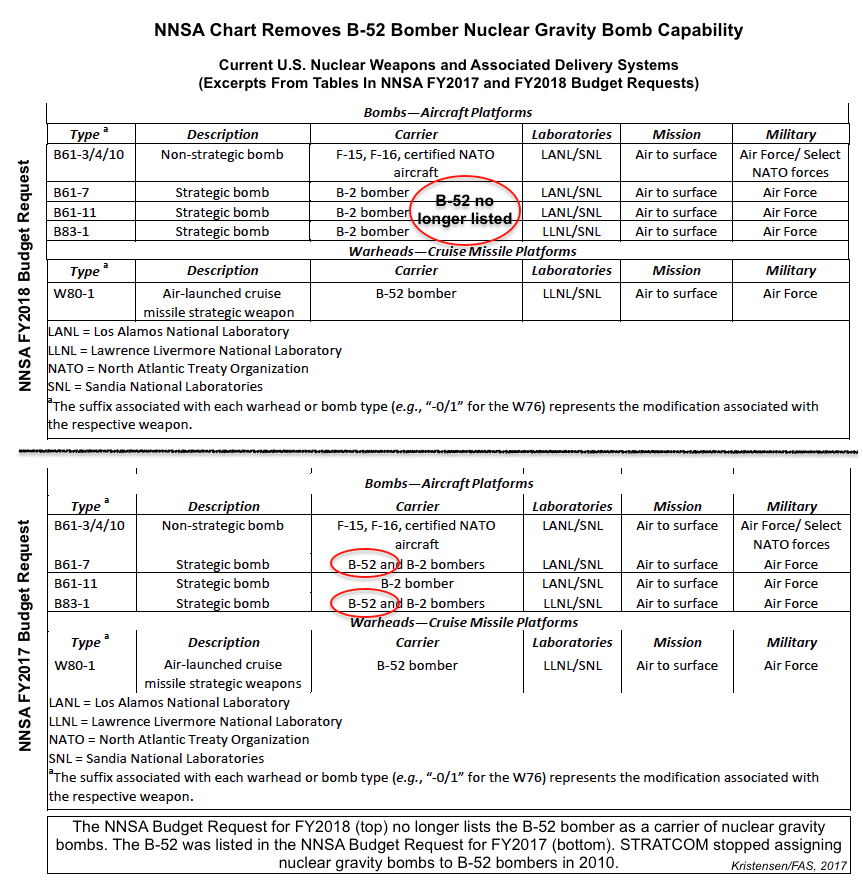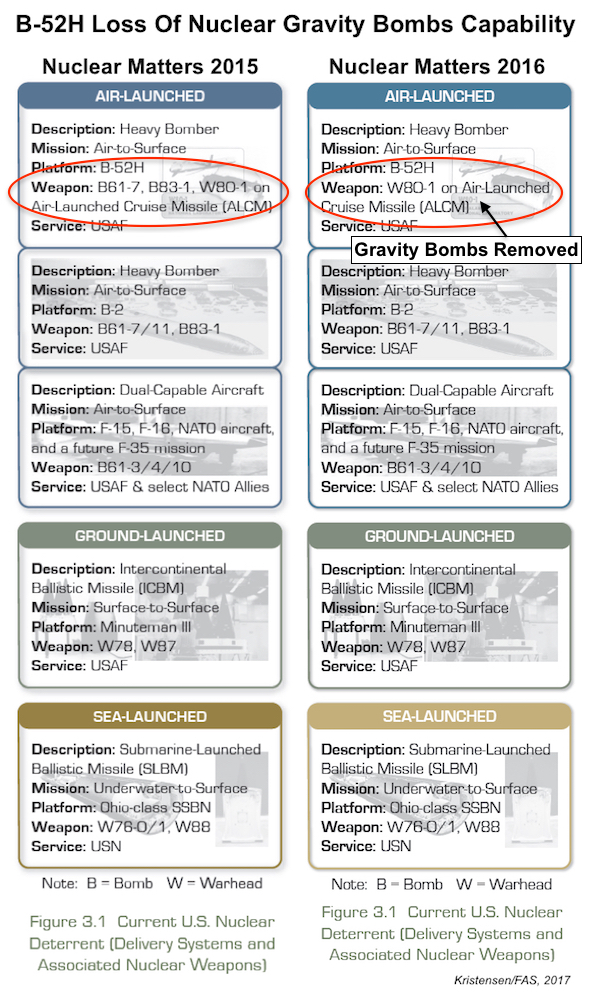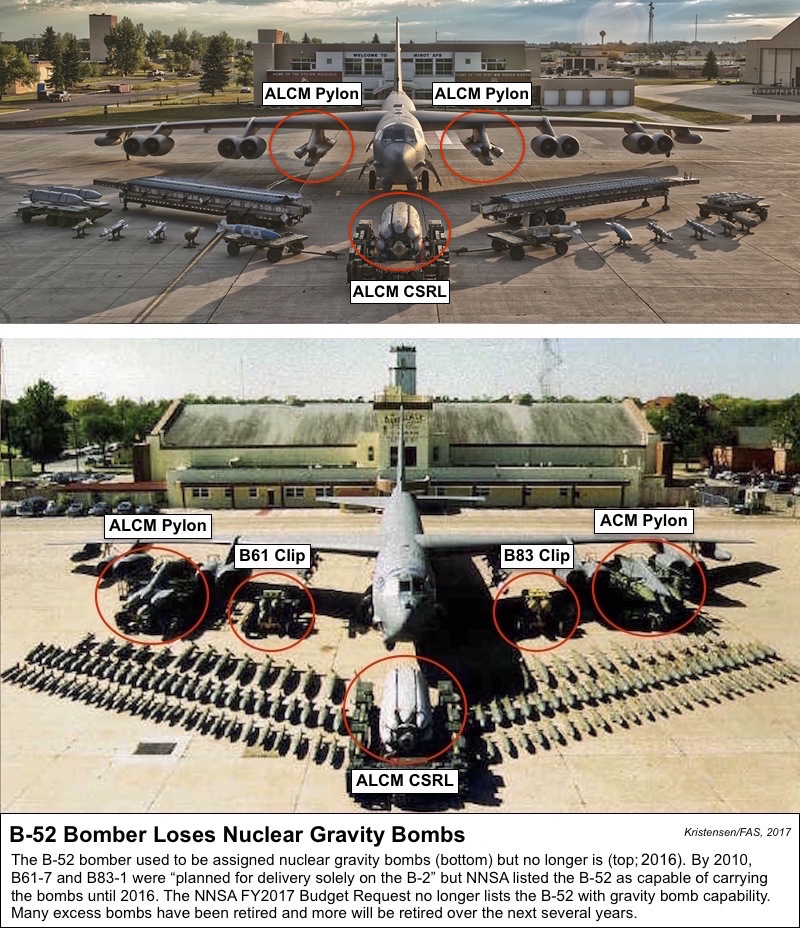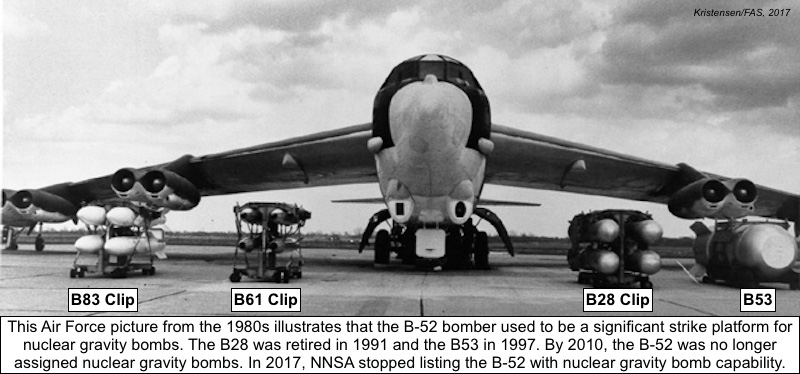B-52 Bomber No Longer Delivers Nuclear Gravity Bombs
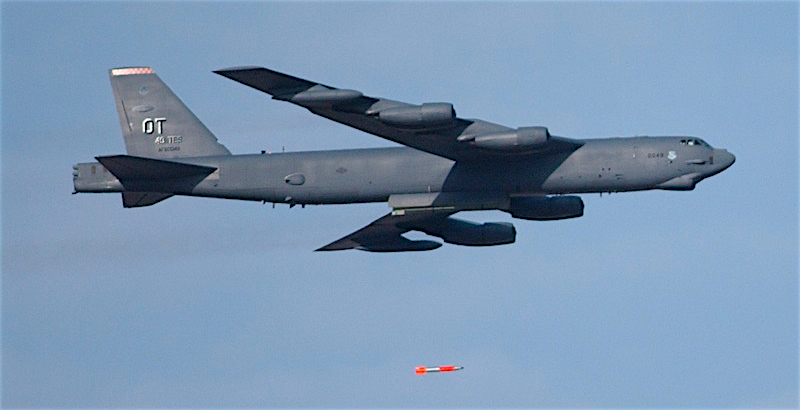
A B-52H bomber conducts a B61-7 nuclear gravity bomb drop test at the Tonopah Test Range in Nevada. Image: NNSA
By Hans M. Kristensen
The venerable B-52H Stratofortress long-range bomber is no longer listed by the National Nuclear Security Administration (NNSA) with a capability to deliver nuclear gravity bombs.
US Strategic Command (STRATCOM) apparently has not been assigning nuclear gravity bombs to B-52 bombers since at least 2010. Today, only the 20 B-2 stealth-bombers are tasked with strategic nuclear gravity bombs under the nuclear strike plans.
The reason for the change appears to be that the B-52 is no longer considered survivable enough to slip through modern air-defenses and drop nuclear gravity bombs on enemy territory.
The B-52s is still equipped to carry the nuclear-armed air-launched cruise missile (ALCM or AGM-86B), which can be launched from well outside the reach of air-defenses, and is scheduled to receive the new LRSO (Long Range Standoff Missile) by the late-2020s (even though that’s probably unnecessary).
Nuclear Tell Signs
The loss of the B-52 nuclear gravity bomb mission is visible in NNSA’s Budget Request for FY2018, which only lists the B-2 as carrier of the strategic nuclear gravity bombs. The Budget Request for FY2017, in contrast, also listed the B-52 as carrier of the B61-7 and B83-1 bombs (see below).
Update (thanks to hint from Dave): The loss of nuclear gravity bombs is also apparent from the latest update to the Department of Defense’s 2016 volume of Nuclear Matters Handbook. Whereas the 2015 version listed the B-52H with nuclear gravity bombs, chapter 3 of the 2016 version only listed ALCM (see comparison below).
The change is also apparent from photos that over the years were used by the Air Force to showcase the B-52’s firepower. One photo from between 1990 and 2007 shows a B-52 at Barksdale AFB in Louisiana with ALCM and ACM (Advanced Cruise Missile, or AGM-129A) cruise missiles, and B61 and B83 gravity bombs. A later photo from 2016, however, shows the significantly modified loadout of a B-52 at Minot AFB in North Dakota with ALCM cruise missiles but no nuclear gravity bombs. Instead, the bomber’s modernized loadout includes significant new conventional capabilities such as JDAM and SDB guided bombs, and the JASSM cruise missile (see below).
Gradual Nuclear Decline
The B-52 used to be equipped to carry a wide variety of nuclear weapons. Over the years many nuclear weapon have come and gone but the B-52 has endured. In the 1980s, for example, the B-52 was equipped for five different types of nuclear weapons: the 1.4-megaton B28 bomb, the 9-megaton B53 bomb, the 1.2-megaton B83 bomb, the B61 bomb, and the ALCM (see picture below).
When the Advanced Cruise Missile (ACM) entered service in 1990 it was also added to the B-52 nuclear portfolio. Despite the new ALCM and ACM standoff weapons (the ACM was retired in 2007, however, the B-52 continued to be assigned missions with nuclear gravity bombs. The 9-megaton B53 that was declared unsafe in 1991 was retained in the stockpile until 1997 for delivery by B-52s against super-hardened underground targets.
Instead of nuclear weapons, however, the overall trend is clear: the B-52 has been gradually shifting from nuclear to conventional missions. The most recent example is the conversion of some of the nuclear CSRLs (Common Strategic Rotary Launcher) to the Conventional Rotary Launcher (CRL) that can accommodate a wider host of advanced conventional weapons in the bomb bay, including the long-range JASSM-ER that is replacing the conventional ALCM (CALCM).
Given that the new LRSO will also be integrated on the B-2 and the new B-21 bombers, and the B-52 now has long-range conventional standoff JASSM-ER missiles, the B-52 could probably be phased out of the nuclear mission when the ALCM retires in the late-2020s.
The apparent removal of the B-52 from the nuclear gravity bomb mission is particularly important now because NNSA and the military are promising that once they get the new B61-12 guided nuclear bomb then the overall number of nuclear gravity bombs in the stockpile can be reduced by 50%. That promise was an important sales pitch in convincing the Obama administration that the B61-12 modernization was consistent with the goal of reducing the number of nuclear weapons. What the B61-12 lobbyists did not say was that most (if not all) of those 50% of the nuclear gravity bombs were already in excess of national security needs and could have been retired years ago.
Additional background information:
- FAS Nuclear Notebook: US nuclear forces, 2017 (note: publication was researched and produced before the Obama administration announced 500-warhead reduction of stockpile in early 2017. Our updated numbers are here).
- Increasing Nuclear Bomber Operations.
- LRSO: The Nuclear Cruise Missile Mission.
- Forget LRSO: JASSM Can Do The Job.
- W80-1 Warhead Selected For New Nuclear Cruise Missile.
- B-2 Stealth Bomber To Carry New Nuclear Cruise Missile.
This publication was made possible by a grant from the Carnegie Corporation of New York, the New Land Foundation, and the Ploughshares Fund. The statements made and views expressed are solely the responsibility of the author.
Satellite imagery has long served as a tool for observing on-the-ground activity worldwide, and offers especially valuable insights into the operation, development, and physical features related to nuclear technology.
This report outlines a framework relying on “Cooperative Technical Means” for effective arms control verification based on remote sensing, avoiding on-site inspections but maintaining a level of transparency that allows for immediate detection of changes in nuclear posture or a significant build-up above agreed limits.
The grant comes from the Carnegie Corporation of New York (CCNY) to investigate, alongside The British American Security Information Council (BASIC), the associated impact on nuclear stability.
Satellite imagery of RAF Lakenheath reveals new construction of a security perimeter around ten protective aircraft shelters in the designated nuclear area, the latest measure in a series of upgrades as the base prepares for the ability to store U.S. nuclear weapons.
